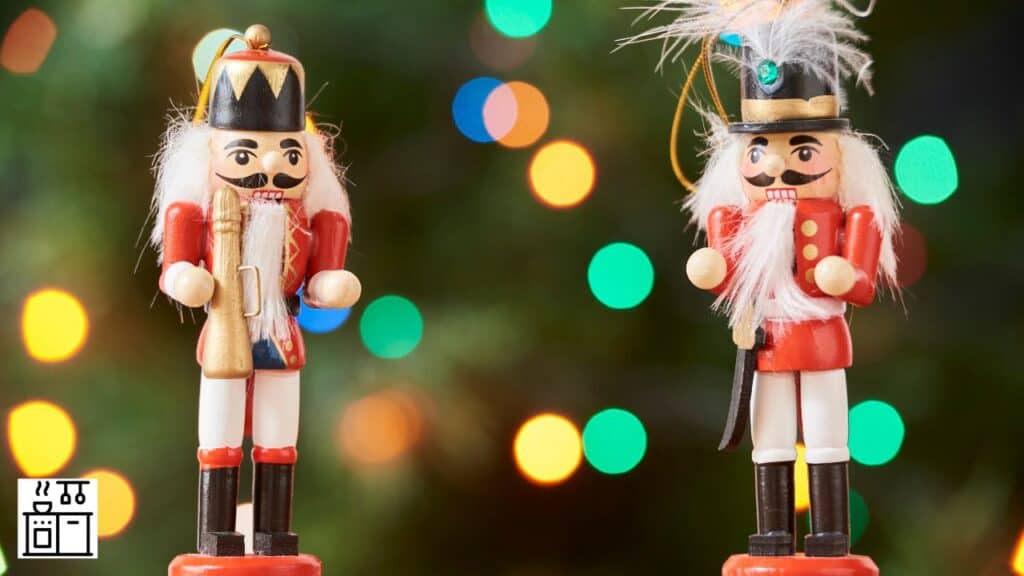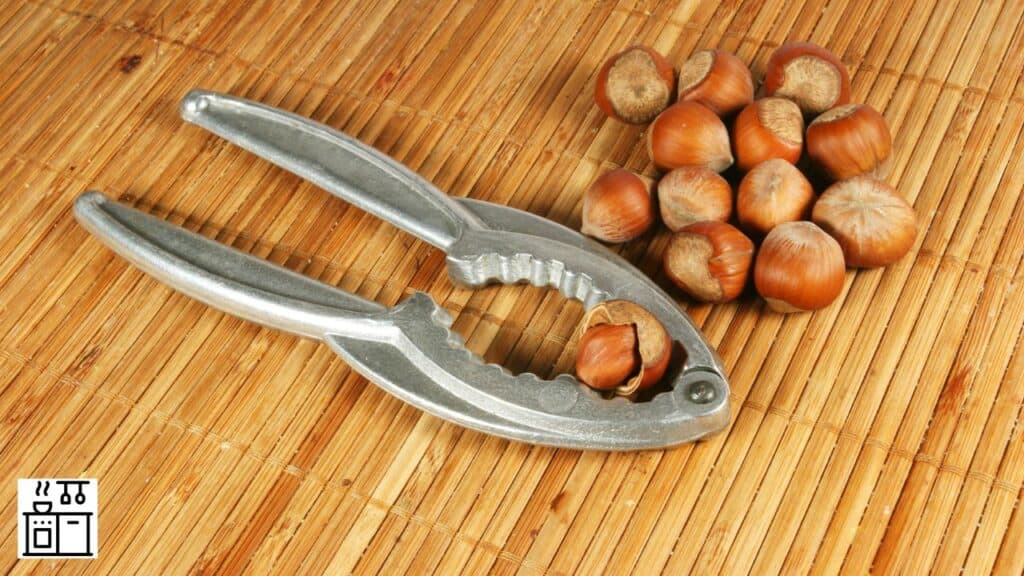Nutcrackers are tools designed for cracking nuts. These tools have been around since ancient times. They were simple lever devices made from two pieces of metal or wood that crushed hard shells to reveal the edible kernels inside. Today, they’ve evolved into intricate works of art cherished by collectors worldwide.
Nutcrackers also hold an esteemed place in cultural lore. For instance, Tchaikovsky’s beloved ballet, “The Nutcracker,” tells the story of a little girl’s magical Christmas Eve adventure with her enchanted nutcracker doll. This has helped cement these figures as quintessential symbols of holiday celebrations.
What Are the Functions of A Nutcracker?
You might have encountered nutcrackers during holiday feasts, cracking open walnut shells, or even used as decorative items adorning your mantelpiece. But do you know how they function?
Modern Nutcracker Designs
Modern nutcrackers bear resemblance to pliers, with their pivot point located at one end rather than in the middle.
This design allows for maximum force application on the shell of a nut, making it easier to crack open and get to the nutritious kernel inside.
These aren’t just for nuts, though. They’re versatile tools that can tackle more than walnuts and almonds.
Use of Nutcrackers for Cracking Lobster and Crab Shells
Ever been to a seafood feast? Then you’ve probably seen nutcrackers in action as they effortlessly crack open crab and lobster shells. In this context, they’re often referred to as ‘lobster crackers’ or ‘crab crackers’.
These useful devices work on the same principle as when cracking nuts – by applying pressure until the hard exterior breaks open. The result? You’ll have easy access to the delicious meat tucked away inside those tough shells.
Historically, people used hammers or anvils made from stone to crack open nuts. Even hands were employed where possible.
However, modern nutcracker designs provide an effective yet straightforward way for everyone around your dinner table – regardless if you’re serving up roasted almonds or fresh lobster tail.
Remember that charming wooden soldier nutcracker from last Christmas?
While today’s functional designs are typically metal-made, resembling pliers, history had its share of beautifully crafted models made from silver, cast iron or bronze, boxwood, and even porcelain.
Alternative Designs of Nutcrackers
Let’s crack open the history and explore some fascinating alternative designs of nutcrackers.
You might be familiar with the lever design, but did you know there are other variants like screw and ratchet nutcrackers?
Screw Nutcrackers
In the 17th century, screw nutcrackers made their appearance. They worked much like a vise, exerting gradual pressure on the shell.
This method was gentle yet effective at cracking open nuts without causing too much damage to the precious kernel inside.
An interesting trivia is that Henry Quackenbush patented the spring-jointed nutcracker in 1913.
Ratchet Nutcrackers
Fast forward to 1947, a new player entered the arena – ratchet nutcrackers. Just think about your car jack; it’s that kind of mechanism.
Crackerjack started using this design under Cuthbert Leslie Rimes’ patent from Morley, Leeds. It slowly increased pressure on the shell to keep intact as much of your tasty kernel as possible.
But let’s not forget about China! Unshelled nuts remain popular there even today with a unique device for cracking them open getting all attention: A key-like insert is twisted into walnuts, pecans, and macadamias to burst the shells open.
What Are Decorative Nutcrackers?
You’ve probably seen decorative nutcrackers around, particularly during the holiday season. But did you know there’s a rich history behind these unique ornaments?
History of Figurative Nutcrackers
Dating back to at least the 15th century, figurative nutcrackers have taken the forms of soldiers, knights, kings, and various professions.
Originating in Germany as a symbol of good luck, they were brought to life by puppet makers who cleverly designed these dolls with lever-operated mouths for cracking nuts.
The big-toothed mouth would open when you lifted a lever at the back. You’d pop your nut in there and press down – voila! Your nut is cracked.
Nowadays, though, these nutcracking figurines are mostly used for decoration rather than their original purpose.
They have become traditional symbols around Christmas time and even inspired Tchaikovsky’s famous ballet “The Nutcracker”.
The carving of these unique decorations developed as a cottage industry in rural areas of Germany, like Sonneberg in Thuringia and Seiffen, amidst wooden toymaking industries located within forested zones.
With names such as Junghanel, Klaus Mertens, and Steinbach attached to them, these hand-crafted treasures serve not just as festive decor but also coveted collector items.
Use of Nutcrackers as Decoration

Decorative nutcrackers gained popularity in the United States post World War II following exposure during the war and after staging “The Nutcracker” ballet stateside in the 1940s.
Though most decorative versions aren’t functional today, you could still get your hands on expensive working ones if that tickles your fancy!
Back then, however, German woodworkers mass-produced designs specifically for US markets after being caught up in Soviet zones post-war.
Sadly enough, with pre-shelled nuts becoming more common along with Chinese and Taiwanese imports replicating traditional German designs took over from the 1980s onward, leading to less need for functionality.
Despite this shift away from functionality toward purely decorative use cases, today’s nutcracker remains beloved, especially during holidays, with porcelain silver brass variants making their way into homes alongside wooden ones.
Did you know about Leavenworth Washington’s recreated Bavarian village featuring a dedicated museum or USPS issuing four stamps featuring custom-made nutcrackers by Richmond-based artist Glenn Crider?
That’s how deeply ingrained they are within popular culture.
Decline in Nutcracker Ownership and Tradition
In the past, nutcrackers held a prominent place in many homes. They were not just tools but also symbols of tradition and celebration. Unfortunately, times have changed.
Rise of Pre-Shelled Nuts
The availability of pre-shelled nuts skyrocketed after the 1960s. Why crack your own nuts using a nutcracker when you can buy them already shelled?
Convenience took over tradition, leading to a sharp drop in nutcracker ownership. People no longer saw the need for these once-essential household items.
| Decades | Nutcracker Ownership |
|---|---|
| Before 1960 | High |
| After 1960 | Low |
This shift wasn’t merely about convenience; it was also about economics.
Pre-shelled nuts meant less work for consumers and more profit for suppliers. It was a win-win situation that, unfortunately, left nutcrackers out in the cold.
The Decline of Nutcrackers as Christmas Stocking Fillers
There was another change impacting nutcrackers: their diminishing role as a stocking filler at Christmas time.
This tradition where children found small gifts like candies, oranges, or, indeed, nuts with their accompanying nutcrackers in their stockings has faded away.
Kids today might wonder what to do with an actual nut placed inside their holiday stockings! They’re more likely expecting candy canes or toys instead – which don’t need to be cracked open.
As these shifts continue, it’s clear that nutcrackers are becoming relics of an earlier time—a time when preparing food was part of the experience itself and traditions weren’t overridden by convenience.
Other Uses of Nutcrackers
Beyond their practical function, nutcrackers have found their way into various aspects of human culture. They’ve become more than just handy kitchen tools.
Let’s dive into a couple of other ways you’re likely to see nutcrackers.
Nutcrackers in Music
You might not think it, but even the humble nutcracker has a role in the world of music.
Multi-instrumentalist Mike Oldfield is one notable artist who’s used the distinct sound that nutcrackers make in his compositions.
By incorporating this unique percussive noise, he injects a sense of real-world texture and rhythm into his music.
It’s an interesting example of how everyday objects can add depth and richness to our auditory experiences.
Nutcrackers as Cultural Beliefs
Nutcrackers also hold symbolic importance in certain cultures.
In Southeast Asia, for instance, there’s an old belief among the Malay people surrounding areca nutcrackers – locally known as kacip pinang. These aren’t just seen as tools but instead, carry spiritual significance.
According to tradition, placing an areca nutcracker under a baby’s pillow serves as protection against harm from paranormal creatures. This shows how deeply ingrained these simple devices can be in cultural practices and beliefs.
Nutcrackers in Animals
Let’s dive into the fascinating world of animals that act as natural nutcrackers.
Capuchin monkeys have been found to skillfully crack open nuts. It’s a testament to their ingenuity and adaptability in the wild.
Moreover, parrots employ their strong beaks as built-in nutcrackers, effortlessly cracking open tough shells. They’re not alone, either!
Smaller birds often exhibit this knack for nut-cracking too.

